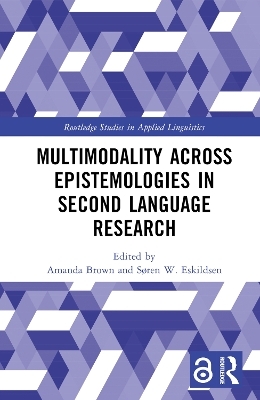
Multimodality across Epistemologies in Second Language Research
Routledge (Verlag)
978-1-032-40981-8 (ISBN)
This collection highlights diverse epistemological perspectives in original research on the important role of multimodality in second language contexts.
The volume explores a wide range of theoretical and methodological traditions toward foregrounding the notion that bodily action is not merely an add-on to the modality of talk but an integral part of second language teaching, learning, and interaction. Following an introductory chapter, 18 empirical chapters feature either classroom or non-classroom research, which shed light on different dimensions of multimodality in second language contexts, including learning reflected in gesture, learning gesture across languages, the role of bodily action in language teaching, and the role of movement in configuring space for effective communication. Each empirical chapter follows a consistent structure detailing the research focus, the background to each study, methodology, and findings. A concluding synthesis chapter braids the insights of these chapters, drawing parallels across different methods, and pointing toward crosscutting areas for future research.
This book will be of interest to students and scholars in applied linguistics, multilingualism, bilingualism, gesture studies, cognitive science, and psychology.
Chapters 10 and 11 of this book are available for free in PDF format as Open Access at www.taylorfrancis.com. They has been made available under a Creative Commons Attribution-NonCommercial-ShareAlike (CC-BY-NC-SA) 4.0 International license.
Amanda Brown is Associate Professor of Linguistics and Director of the Linguistic Studies Program at Syracuse University, USA. She investigates the psycholinguistic effects of multicompetence and associated implications for gesture, language pedagogy and assessment, language across the curriculum, and (equity in) language teacher preparation. Søren W. Eskildsen is Associate Professor at the Department of Design, Media and Educational Science, University of Southern Denmark. His research interests concern interactional processes and practices in L2 learning in situ and over time, approached from the perspective of usage-based linguistics and multimodal conversation analysis. He works with in- and out-of-class data.
List of Contributors
Chapter 1: An Introduction to Multimodality across Epistemologies in Second Language Research, Søren W. Eskildsen and Amanda Brown
Chapter 2: Gesture as a Means for Communicating and Understanding Embodied Conceptualizations in Second Language Interactions, Jana Bressem and Silva Ladewig
Chapter 3: Language, Embodiment and the Material Ecology: Embodied and Material Resources for Repairs in Second Language Interactions, Søren W. Eskildsen and Johannes Wagner
Chapter 4: Multimodality and Contingency Teaching: Promoting Interactive Read-alouds for Elementary Second Language Learners., Alessandro Rosborough and Jennifer J. Wimmer
Chapter 5: How Flexible seating Redefines the Place of the Body in the Language Classroom, Marion Tellier
Chapter 6: Learning to Embody the Teacher, Keli Yerian and Marion Tellier
Chapter 7: Conflicting Deictic Gestures in EFL Classrooms: Their Frequency, Mechanisms, and Learner Perception, Nobuhiro Kamiya
Chapter 8: Multimodal and Materially Embedded Meaning in L2 Interaction: Explaining and Understanding New Vocabulary, Søren W. Eskildsen
Chapter 9: The Effectiveness of Hand Gestures on the Development of L2 French Pronunciation, Solène Inceoglu and Ruri Ueda
Chapter 10: A Comparison of Gesture Production in L1 and L2 During a Video-mediated Task-based Teletandem Interaction, Benjamin Holt
Chapter 11: Gesture Shape and Gesture-speech Alignment Predict Simultaneous L2 Sound Production Accuracy, Peng Li, Florence Baills, Xiaotong Xi, and Pilar Prieto
Chapter 12: Patterned Iconicity for Second Language Acquisition: Differential Effects of Gesture Type on Lexical Category, Tasha N. Lewis, Matthew W. Kirkhart, and Elise Stickles
Chapter 13: Does Gesture Help L2 English Users Interpret Ambiguous Sentences with Quantification and Negation?, Amanda Brown and Masaaki Kamiya
Chapter 14: Predicting Gesture Use among Bilingual and Monolingual Children
Lauren Daley, Eugenia Gokhman, Christina Pechey, and Elena Nicoladis
Chapter 15: What Speech and Gesture Illustrate About the Thinking-for-Speaking Patterns of Child isiXhosa Speakers Learning English, Gale Stam, Heather Brookes, and Unathi Ngumbela
Chapter 16: Predictors of Gesture Viewpoint in L2: A Generalized Linear Mixed Models Analysis, Christopher Hromalik and Amanda Brown
Chapter 17: What Does Gesture Size Tell Us about L2 Language Acquisition and Use?: Gestures Accompanying Ideophones in L2 Japanese, Keiko Yoshioka and Noriko Iwasaki
Chapter 18: Gesturing the Discourse Marker Entonces in Native Speakers and Learners of Spanish, Renia Lopez-Ozieblo
Chapter 19: How ESL Speakers Use Gestures in Conversation and in Storytelling, Elena Nicoladis, Fajar Khan, and Xiaoting Li
Chapter 20: A Concluding Synthesis for Multimodality across Epistemologies in Second Language Research, Amanda Brown and Søren Wind Eskildsen
Index
| Erscheinungsdatum | 05.04.2024 |
|---|---|
| Reihe/Serie | Routledge Studies in Applied Linguistics |
| Zusatzinfo | 21 Tables, black and white; 35 Line drawings, black and white; 7 Halftones, black and white; 42 Illustrations, black and white |
| Verlagsort | London |
| Sprache | englisch |
| Maße | 152 x 229 mm |
| Gewicht | 800 g |
| Themenwelt | Geisteswissenschaften ► Psychologie ► Allgemeine Psychologie |
| Geisteswissenschaften ► Psychologie ► Verhaltenstherapie | |
| Geisteswissenschaften ► Sprach- / Literaturwissenschaft ► Anglistik / Amerikanistik | |
| Geisteswissenschaften ► Sprach- / Literaturwissenschaft ► Literaturwissenschaft | |
| Geisteswissenschaften ► Sprach- / Literaturwissenschaft ► Sprachwissenschaft | |
| Sozialwissenschaften ► Pädagogik | |
| ISBN-10 | 1-032-40981-9 / 1032409819 |
| ISBN-13 | 978-1-032-40981-8 / 9781032409818 |
| Zustand | Neuware |
| Haben Sie eine Frage zum Produkt? |
aus dem Bereich


